1. Ayar Madenli A, Öz İ, Gürbüz T. The relationship between antimullerian hormone level and endometrial polyp frequency in patientswith polycystic ovary syndrome. J Med Palliat Care. 2022;3(3):263-267.https://doi.org/10.47582/jompac.1148111
2. Gleicher N, Darmon S, Patrizio P, Barad DH. Reconsidering thepolycystic ovary syndrome (PCOS). Biomedicines. 2022;10(7):1505.doi:10.3390/biomedicines10071505
3. Gürbüz T, Gökmen O, Güngör ND. Polikistik over sendromu bulunankadınlarda glikoz potasyum oranının tanısal değerinin insülin ilekarşılaştırılması. Çukurova Med J. 2021;46(1):381-386.
4. Alanya Tosun Ş, Gürbüz T, Cebi A, Tosun A, Gokmen O, Usta M.Association of increased levels of omentin-1 and carotid intima-mediathickness with early signs of cardiovascular risk in patients withpolycystic ovary syndrome: a prospective case control study. J ObstetGynaecol Res. 2022;48(1):169-177. doi:10.1111/jog.15077
5. Melo AS, Vieira CS, Barbieri MA, et al. High prevalence of polycysticovary syndrome in women born small for gestational age. Hum Reprod.2010;25(8):2124-2131. doi:10.1093/humrep/deq162
6. Balen AH, Rutherford AJ. Managing anovulatory infertility andpolycystic ovary syndrome. BMJ. 2007;335(7621):663-666. doi:10.1136/bmj.39335.462303.80
7. Shayan A, Masoumi S, Shobeiri F, Ahmadinia H. Analysis of the factorsaffecting polycystic ovary syndrome. Iranian J Obstet Gynecol Infertil.2017;19(36):11-18.
8. Gürbüz T, Gökmen O, Ayar Madenli A, Dilbaz B. R-Spondin1 andtumor necrosis factor-alpha in infertile women with polycystic ovarysyndrome: relationships with insulin resistance and other parameters. JHealth Sci Med. 2023;6(2):449-455.
9. Urhan E, Elbuken G, Hacioglu A, Karaca Z, Unluhizarci K, KelestimurF. Ovarian functions and polycystic ovary syndrome in adult womenwith type 1 diabetes mellitus in a Turkish population. J EndocrinolInvest. 2023;46(3):609-616. doi:10.1007/s40618-022-01946-9
10. Rababa’h AM, Matani BR, Yehya A. An update of polycystic ovarysyndrome: causes and therapeutics options. Heliyon. 2022;8(10):e11010.doi:10.1016/j.heliyon.2022.e11010
11. Paoli A, Mancin L, Giacona MC, Bianco A, Caprio M. Effectsof a ketogenic diet in overweight women with polycystic ovarysyndrome. J Transl Med. 2020;18(1):104. doi:10.1186/s12967-020-02277-0
12. Kordi M, Motiei Z, Amirsasan R, Letafatkar K. The effect of aerobicexercise on biochemical parameters in women with polycystic ovarysyndrome. Res Rehabil Sci. 2009;5(2):63-72.
13. Barber TM, Wass JA, McCarthy MI, Franks S. Metabolic characteristicsof women with polycystic ovaries and oligo-amenorrhoea but normalandrogen levels: implications for the management of polycystic ovarysyndrome. Clin Endocrinol (Oxf). 2007;66(4):513-517. doi:10.1111/j.1365-2265.2007.02764.x
14. Carmina E, Chu MC, Longo RA, Rini GB, Lobo RA. Phenotypicvariation in hyperandrogenic women influences the findings ofabnormal metabolic and cardiovascular risk parameters. J ClinEndocrinol Metab. 2005;90(5):2545-2549. doi:10.1210/jc.2004-2279
15. Burgers JA, Fong SL, Louwers YV, et al. Oligoovulatory andanovulatory cycles in women with polycystic ovary syndrome (PCOS):what’s the difference? J Clin Endocrinol Metab. 2010;95(12):E485-E489.doi:10.1210/jc.2009-2717
16. Kang H. Sample size determination and power analysis using theG*Power software. J Educ Eval Health Prof. 2021;18:17. doi:10.3352/jeehp.2021.18.17
17. Panidis D, Tziomalos K, Misichronis G, et al. Insulin resistance andendocrine characteristics of the different phenotypes of polycysticovary syndrome: a prospective study. Hum Reprod. 2012;27(2):541-549.doi:10.1093/humrep/der418
18. Hosseinpanah F, Barzin M, Keihani S, Ramezani Tehrani F, AziziF. Metabolic aspects of different phenotypes of polycystic ovarysyndrome: Iranian PCOS Prevalence Study. Clin Endocrinol (Oxf).2014;81(1):93-99. doi:10.1111/cen.12406
19. Gupta M, Yadav R, Mahey R, et al. Correlation of body mass index(BMI), anti-mullerian hormone (AMH), and insulin resistance amongdifferent polycystic ovary syndrome (PCOS) phenotypes - a cross-sectional study. Gynecol Endocrinol. 2019;35(11):970-973. doi:10.1080/09513590.2019.1613640
20. Al-Jefout M, Alnawaiseh N, Al-Qtaitat A. Insulin resistance and obesityamong infertile women with different polycystic ovary syndromephenotypes. Sci Rep. 2017;7(1):5339. doi:10.1038/s41598-017-05717-y
21. Shirazi FKH, Khodamoradi Z, Jeddi M. Insulin resistance and highmolecular weight adiponectin in obese and non-obese patientswith polycystic ovarian syndrome (PCOS). BMC Endocr Disord.2021;21(1):45. doi:10.1186/s12902-021-00710-z
22. Sachdeva G, Gainder S, Suri V, Sachdeva N, Chopra S. Comparisonof the different PCOS phenotypes based on clinical metabolic, andhormonal profile, and their response to clomiphene. Indian J EndocrinolMetab. 2019;23(3):326-331. doi:10.4103/ijem.IJEM_30_19
23. Moghetti P, Tosi F, Bonin C, et al. Divergences in insulin resistancebetween the different phenotypes of the polycystic ovary syndrome. JClin Endocrinol Metab. 2013;98(4):E628-E637. doi:10.1210/jc.2012-3908
24. Mansour A, Mirahmad M, Mohajeri-Tehrani MR, et al. Risk factors forinsulin resistance related to polycystic ovarian syndrome in Iranianpopulation. Sci Rep. 2023;13(1):10269. doi:10.1038/s41598-023-37513-2
25. Guastella E, Longo RA, Carmina E. Clinical and endocrinecharacteristics of the main polycystic ovary syndrome phenotypes.Fertil Steril. 2010;94(6):2197-2201. doi:10.1016/j.fertnstert.2010.02.014

